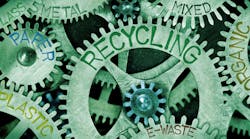Loosely defined as both consumer and business electronic equipment that’s at or near the end of its useful life, e-waste is becoming a hot topic for companies as consumers’ environmental concerns impact their spending habits and purchase decisions.
Global e-waste production is on track to reach 120 million tons per year by 2050 if current trends continue, according to the Platform for Accelerating the Circular Economy (PACE) and the UN E-Waste Coalition.
In a new report, the organizations place the annual value of global e-waste at over $62.5 billion—more than the GDP of most countries. “More than 44 million tons of electronic and electrical waste were produced globally in 2017—over six kilograms for every person on the planet,” PACE and the UN point out. “This is equivalent in weight to all the commercial aircraft ever built.”
Key Culprits
As e-waste continues to pile up worldwide, one of the culprits is the fact that less than 20% of e-waste is formally recycled, with 80% either ending up in landfill or being informally recycled—much of it by hand in developing countries, exposing workers to hazardous and carcinogenic substances such as mercury, lead, and cadmium. According to the groups, e-waste in landfill contaminates soil and groundwater, putting food supply systems and water sources at risk.
Along with health and pollution impacts, improper management of e-waste is creating a “significant loss of scarce and valuable raw materials, such as gold, platinum, cobalt, and rare earth elements,” PACE and the UN point out. “As much as 7% of the world’s gold may currently be contained in e-waste, with 100 times more gold in a ton of e-waste than in a ton of gold ore.”
So what’s the answer? According to the organizations, possible solutions include:
- More durable product design
- Buy-back and return systems for used electronics
- Urban mining to extract metals and minerals from e-waste
- The dematerialization of electronics (i.e., replacing outright device ownership with rental and leasing models in order to maximize product reuse and recycling opportunities)
Some companies are already making strides with these and other e-waste reduction efforts. In “Dell Continues to Close the Loop on E-waste,” Nithin Coca discusses how Dell continues to make headway on its plans to dramatically increase the amount of repurposed and reclaimed content in its supply chain, with a goal of 100 million pounds of reused materials in its products by 2020 (double its original goal of 50 million, which it achieved in 2017).
“Its model could provide the entire industry with methods, practices, and—through collaboration—opportunities to reduce the growing global e-waste problem,” Coca writes, “and shift towards a more circular economy in the electronics sector.”
Calling Dell a “leader in addressing e-waste for a decade,” since the launch of the Dell Reconnect program more than a decade ago, Coca points out that the company partnered with Goodwill to establish more than 2,000 U.S. e-waste recycling centers, which accepted used electronics from all manufacturers (not just Dell). Later, the electronics manufacturer launched a partnership with the UN to tackle e-waste in the developing world.
But according to Coca, it’s going to take more than just recycling programs to make a dent in the world’s e-waste problem. “Ultimately, we need a circular economy for electronics,” he writes, “where materials are used in a closed-loop system, with little or no waste ending up in landfills.”
A Tsunami of E-Waste
“Humankind’s insatiable demand and consumption of electronic devices is creating the world’s fastest growing waste stream,” Guy Ryder writes in “A New Circular Vision for Electronics.” “Some forms are growing exponentially. The United Nations is calling it a tsunami of e-waste.”
According to Ryder, the “mushrooming pile of screens, cables, chips, and motherboards fueled by our love of devices, many connected to the internet” now exceeds the number of humans on the planet. And that number is expected to grow to 25-50 billion by 2020, reflecting plummeting costs and rising demand, he adds.
To do its part in helping to whittle that number down, procurement can focus on better e-waste management strategies and greener business practices. “By all coming together on the global stage, we can create a sustainable industry that generates less waste, where our devices are reused, as well as recycled in novel ways,” Ryder writes. “This also creates new forms of employment, economic activity, education, and trade.”
Advanced technologies like cloud computing and the Internet of Things (IoT), he adds, can also help with dematerialization. “Better product tracking and take-back schemes, which consumers trust,” Ryder concludes, “also constitute an important first step to circular global value chains.”
For Part 2 of our series on supply chain sustainability, click here










